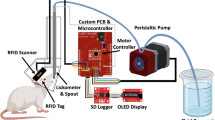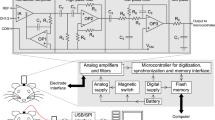Abstract
Virtually all rodents display burrowing behavior, yet measurement of this behavior has not yet been standardized or formalized. Previously, parameters such as the latency to burrow and the complexity of the burrow systems in substrate-filled boxes in the laboratory or naturalistic outdoor environments have been assessed. We describe here a simple protocol that can quantitatively measure burrowing in laboratory rodents, using a simple apparatus that can be placed in the home cage. The test is very cheap to run and requires minimal experimenter training, yet seems sensitive to a variety of treatments, such as the early stages of prion disease in mice, mouse strain differences, lesions of the hippocampus and prefrontal cortex in mice, also effects of lipopolysaccharide and IL-1β in rats. Other species such as hamsters, gerbils and Egyptian spiny mice also burrow in this apparatus, and with suitable size modification probably almost any burrowing animal could be tested in it. The simplicity, sensitivity and robustness of burrowing make it ideal for assessing genetically modified animals, which in most cases would be mice. The test is run from late afternoon until the next morning, but only two measurements need to be taken.
This is a preview of subscription content, access via your institution
Access options
Subscribe to this journal
Receive 12 print issues and online access
$259.00 per year
only $21.58 per issue
Buy this article
- Purchase on Springer Link
- Instant access to full article PDF
Prices may be subject to local taxes which are calculated during checkout

Similar content being viewed by others
References
Dudek, B.C., Adams, N., Boice, R. & Abbott, M.E. Genetic influences on digging behaviours in mice (Mus musculus) in laboratory and seminatural settings. J. Comp. Psychol. 97, 249–259 (1983).
Deacon, R.M.J., Raley, J.M., Perry, V.H. & Rawlins, J.N.P. Burrowing into prion disease. Neuroreport 12, 2053–2057 (2001).
Deacon, R.M.J. Digging and marble burying in mice: simple methods for in vivo identification of biological impacts. Nature Protocols, DOI: 10.1038/nprot.2006.20
Pinel, J.P.J. & Treit, D. Burying as a defensive response in rats. J. Comp. Physiol. Psychol. 92, 708–712 (1978).
Guenther, K., Deacon, R.M.J., Perry, V.H. & Rawlins, J.N.P. Early behavioural changes in scrapie-affected mice and the influence of dapsone. Eur. J. Neurosci., 14, 401–409 (2001).
Contet, C., Rawlins, J.N.P. & Deacon, R.M.J. A comparison of 129S2/SvHsd and C57BL/6JOlaHsd mice on a test battery assessing sensorimotor, affective and cognitive behaviours: implications for the study of genetically modified mice. Behav. Brain Res. 124, 33–46 (2001).
Deacon, R.M.J., Croucher. A. & Rawlins, J.N.P. Hippocampal cytotoxic lesion effects on species-typical behaviors in mice. Behav. Brain Res. 132, 203–213 (2002).
Deacon R.M.J., Penny, C. & Rawlins, J.N.P. Effects of medial prefrontal cortex cytotoxic lesions in mice. Behav. Brain Res. 139, 139–155 (2003).
Deacon R.M.J., Reisel, D., Perry, V.H. & Rawlins, J.N.P. Hippocampal scrapie infection impairs operant DRL performance in mice. Behav. Brain Res. 157, 99–105 (2005).
Shinomiya, K., Fujii, Y., Sugimoto, Y., Azuma, N., Tokunaga, S., Kitazumi, K. & Kamei, C. Effect of paroxetine on marble-burying behavior in mice. Methods Find Exp Clin Pharmacol. 10, 685–687 (2005).
Acknowledgements
This work was supported by grant GR065438MA from the Wellcome Trust to the Oxford OXION group.
Author information
Authors and Affiliations
Corresponding author
Ethics declarations
Competing interests
The author declares no competing financial interests.
Supplementary information
Supplementary Video 1
A hooded Lister rat burrowing. The setup, with a transparent tube and colored granite chips, was specifically for demonstration purposes. Film courtesy of D. Anthony and S. Campbell, Dept. of Pharmacology, University of Oxford. (MOV 35742 kb)
Rights and permissions
About this article
Cite this article
Deacon, R. Burrowing in rodents: a sensitive method for detecting behavioral dysfunction. Nat Protoc 1, 118–121 (2006). https://doi.org/10.1038/nprot.2006.19
Published:
Issue Date:
DOI: https://doi.org/10.1038/nprot.2006.19
This article is cited by
-
Sexual differences in locus coeruleus neurons and related behavior in C57BL/6J mice
Biology of Sex Differences (2023)
-
Patchouli alcohol attenuates the cognitive deficits in a transgenic mouse model of Alzheimer’s disease via modulating neuropathology and gut microbiota through suppressing C/EBPβ/AEP pathway
Journal of Neuroinflammation (2023)
-
Endometriosis leads to central nervous system-wide glial activation in a mouse model of endometriosis
Journal of Neuroinflammation (2023)
-
Robustness of a multivariate composite score when evaluating distress of animal models for gastrointestinal diseases
Scientific Reports (2023)
-
Topical application of a TRPA1 antagonist reduced nociception and inflammation in a model of traumatic muscle injury in rats
Inflammopharmacology (2023)
Comments
By submitting a comment you agree to abide by our Terms and Community Guidelines. If you find something abusive or that does not comply with our terms or guidelines please flag it as inappropriate.



